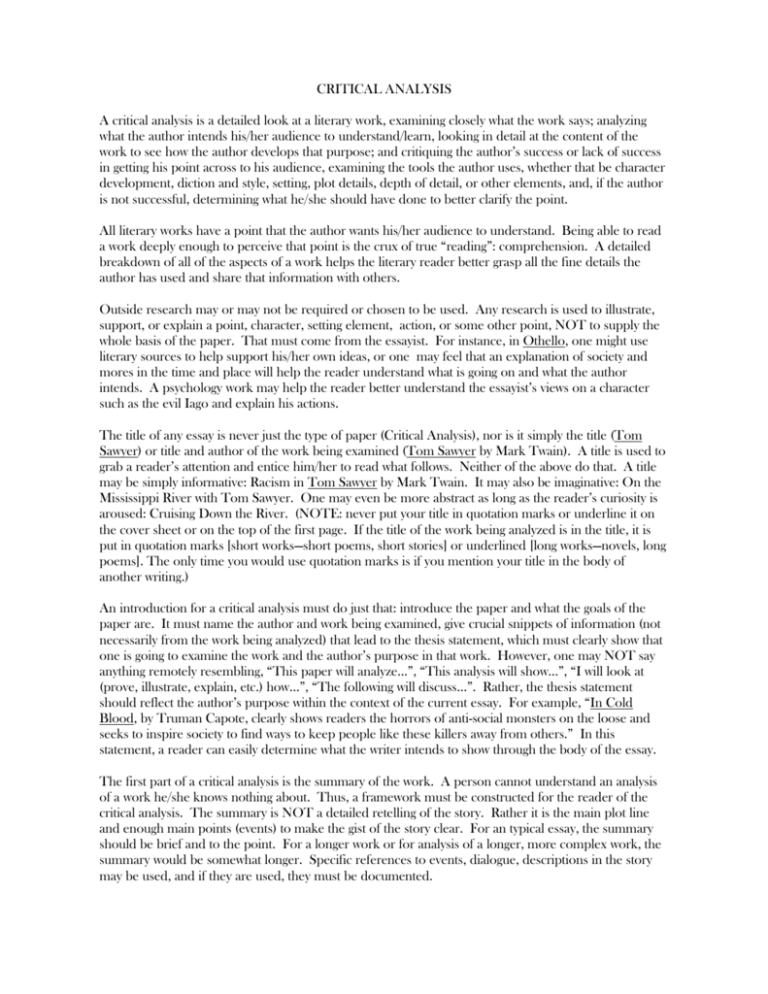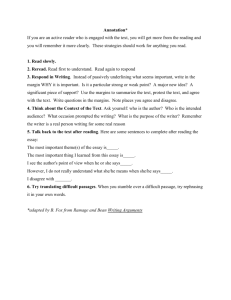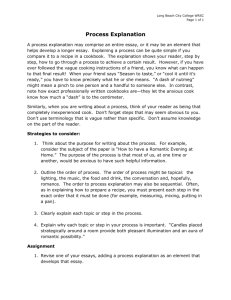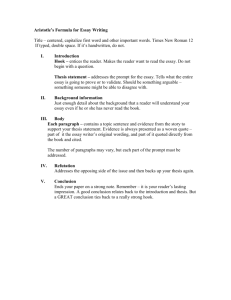CRITICAL ANALYSIS EXPLANATION
advertisement

CRITICAL ANALYSIS A critical analysis is a detailed look at a literary work, examining closely what the work says; analyzing what the author intends his/her audience to understand/learn, looking in detail at the content of the work to see how the author develops that purpose; and critiquing the author’s success or lack of success in getting his point across to his audience, examining the tools the author uses, whether that be character development, diction and style, setting, plot details, depth of detail, or other elements, and, if the author is not successful, determining what he/she should have done to better clarify the point. All literary works have a point that the author wants his/her audience to understand. Being able to read a work deeply enough to perceive that point is the crux of true “reading”: comprehension. A detailed breakdown of all of the aspects of a work helps the literary reader better grasp all the fine details the author has used and share that information with others. Outside research may or may not be required or chosen to be used. Any research is used to illustrate, support, or explain a point, character, setting element, action, or some other point, NOT to supply the whole basis of the paper. That must come from the essayist. For instance, in Othello, one might use literary sources to help support his/her own ideas, or one may feel that an explanation of society and mores in the time and place will help the reader understand what is going on and what the author intends. A psychology work may help the reader better understand the essayist’s views on a character such as the evil Iago and explain his actions. The title of any essay is never just the type of paper (Critical Analysis), nor is it simply the title (Tom Sawyer) or title and author of the work being examined (Tom Sawyer by Mark Twain). A title is used to grab a reader’s attention and entice him/her to read what follows. Neither of the above do that. A title may be simply informative: Racism in Tom Sawyer by Mark Twain. It may also be imaginative: On the Mississippi River with Tom Sawyer. One may even be more abstract as long as the reader’s curiosity is aroused: Cruising Down the River. (NOTE: never put your title in quotation marks or underline it on the cover sheet or on the top of the first page. If the title of the work being analyzed is in the title, it is put in quotation marks [short works—short poems, short stories] or underlined [long works—novels, long poems]. The only time you would use quotation marks is if you mention your title in the body of another writing.) An introduction for a critical analysis must do just that: introduce the paper and what the goals of the paper are. It must name the author and work being examined, give crucial snippets of information (not necessarily from the work being analyzed) that lead to the thesis statement, which must clearly show that one is going to examine the work and the author’s purpose in that work. However, one may NOT say anything remotely resembling, “This paper will analyze…”, “This analysis will show…”, “I will look at (prove, illustrate, explain, etc.) how…”, “The following will discuss…”. Rather, the thesis statement should reflect the author’s purpose within the context of the current essay. For example, “In Cold Blood, by Truman Capote, clearly shows readers the horrors of anti-social monsters on the loose and seeks to inspire society to find ways to keep people like these killers away from others.” In this statement, a reader can easily determine what the writer intends to show through the body of the essay. The first part of a critical analysis is the summary of the work. A person cannot understand an analysis of a work he/she knows nothing about. Thus, a framework must be constructed for the reader of the critical analysis. The summary is NOT a detailed retelling of the story. Rather it is the main plot line and enough main points (events) to make the gist of the story clear. For an typical essay, the summary should be brief and to the point. For a longer work or for analysis of a longer, more complex work, the summary would be somewhat longer. Specific references to events, dialogue, descriptions in the story may be used, and if they are used, they must be documented. The second part of the critical analysis is the actual analysis of the work, looking at the CONTENT of the work. In this section, the essayist looks at what he/she perceives the author is trying to tell the audience. The essay writer then gives a thorough, very detailed examination of how the author built that point, how he developed it, how the essay writer perceived it. This is frequently aided with the use of dialogue, action, and the like. Specific references MUST be used (quotes, paraphrases, summary, reference), and they must be documented. This is NOT a retelling of the story. The third part of the critical analysis is the critique, examining the TOOLS the author used to build his/her work and determining whether or not the author was “successful”, that is, if the reader can relatively easily determine what the author wants readers to grasp or if the reader has to struggle with difficulty to determine the author’s message. Here the essay writer looks at things such as character development, setting, plot development, diction and style, depth of detail, tone, theme, symbolism and metaphor, and imagery. If the essay writer believes that the author is successful, specific elements are used to illustrate how the author achieved that success. If the essay writer concludes that the author is not successful, specific elements are used to illustrate that and suggestions are offered to show how the work could have been improved and made clearer, perhaps with more character development, less setting detail, clearer language, less dialect, and the like. Again, specific references in the work must be used and documented. This section must also be very detailed. The conclusion should, as usual, bring the reader back to the original point, reiterating the main points, and drawing final concluding thoughts and comments. The paper concludes with a separate Works Cited page listing all sources actually used in the essay. Even if the paper is not a formal research paper with multiple sources, one must have a Works Cited for the work being analyzed. The body sections are just that: sections. DO NOT expect to only need one paragraph for each one. The summary may or may not be one paragraph, depending on the length and/or complexity of the work. If the analysis and critique sections are well done, they generally take several paragraphs each because of the depth and thoroughness which the writer will use. Much thought must be put into a good critical analysis. One hopes the writer of the essay is “correct” in the perceived purpose of the author of the work being examined. However, the reality is that often more that one purpose may be seen, based on the background, history, “scripting”, experience, beliefs, and attitude of the person writing the essay. This fact requires that the essayist be detailed, explicit, thorough, thoughtful, insightful, knowledgeable of time and place, and an in-depth reader. Finally, since this is an opinion paper, one may not tell the reader, “In my opinion…” or “I think that…”. The reader knows that the essayist is expressing his/her own opinion. Any outside sources are to support claims, clarify a point or element, explain something, or the like. Make clear assertions and claims and then support them with the work and sources.









